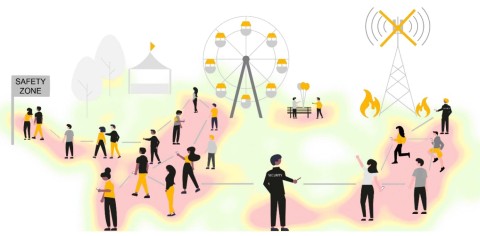RESOLUT
Resilient communication - self-organizing and decentralized
The aim of RESOLUT is to research new technologies that enable people to communicate even when normal communication networks are destroyed or overloaded. The aim is to create autonomous, self-organizing and decentralized communication methods that are independent of base stations and adapt to the current situation. To this end, location-based information is to be collected anonymously in the network, which will help the network to manage itself and thus enable the dissemination of emergency information and also provide situation information for smart city applications and the management of passenger flows.
Project duration:
01.02.2025 - 31.01.2028
Grantor:
Bayerisches Verbundforschungsprogramm - Förderlinie Digitalisierung - Programmteil Informations- und Kommunikationstechnologie (BayVFP)
Project management:
Prof. Dr. Gerta Köster
Prof. Dr. Lars Wischhof
Project partner:
accu:rate GmbH – Institute for Crowd Simulation,
PricewaterhouseCoopers GmbH (PwC)
The flood disaster in the Ahr valley, the wars in Ukraine, Israel and Gaza are drastic reminders of how important and how difficult it is to reach people in danger and need. Which areas need to be evacuated quickly? Where are there shelters? Just when this information is urgently needed, our traditional communication systems fail because important nodes in the network - the base stations - break down. At short-term events such as festivals or demonstrations, a similar technical problem occurs because the infrastructure cannot cope with the additional load. RESOLUT aims to find solutions based on the recognized and widespread 5G/6G standards: The aim of RESOLUT is to develop new technical possibilities for a communication network that is self-sufficient, self-organizing and decentralized. The network is to be created by the users themselves exactly where they are. Each smartphone becomes a node in the network that aggregates and forwards information in a self-organizing manner as required.
In a first step, communication via base stations (5G/6G) is to be supplemented by local, direct connections: 5G/6G Sidelink. Geospatial data values - in particular the number of users in an area - are to be aggregated and disseminated decentrally and anonymously. Cellular communication via base stations is to be combined with direct communication via the sidelink. Local direct communication is intended to compensate for lost connections and network failures. The highlight: local dead spots - for example in the event of a base station failure - can also be bridged by the movement of users. In general, the RESOLUT methods should be suitable for disseminating any kind of location-based information. As part of the project, the benefits will be demonstrated using specific example applications.
